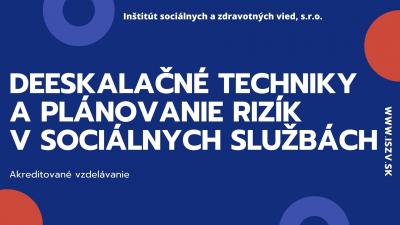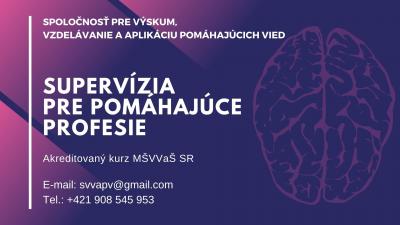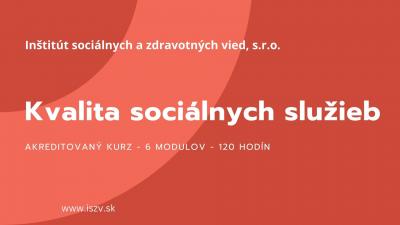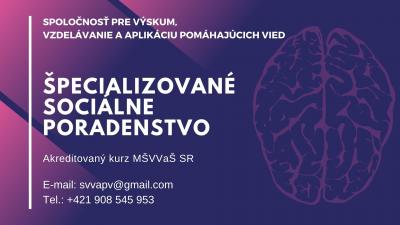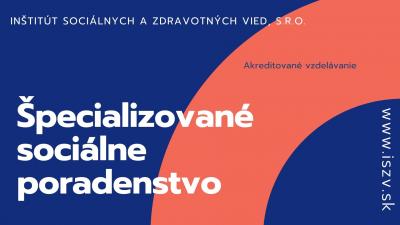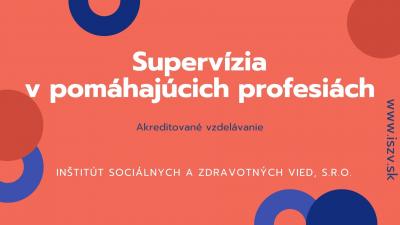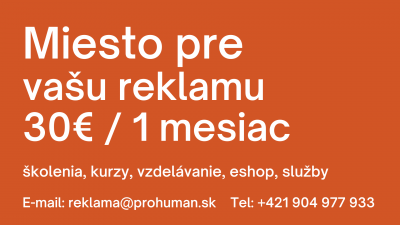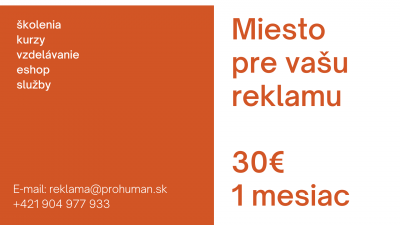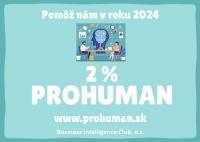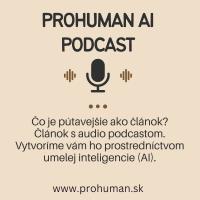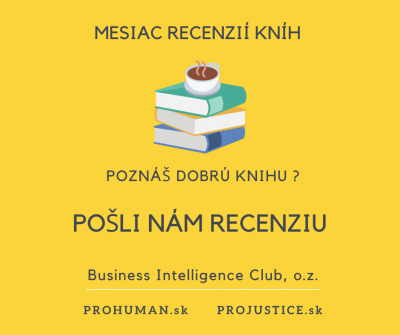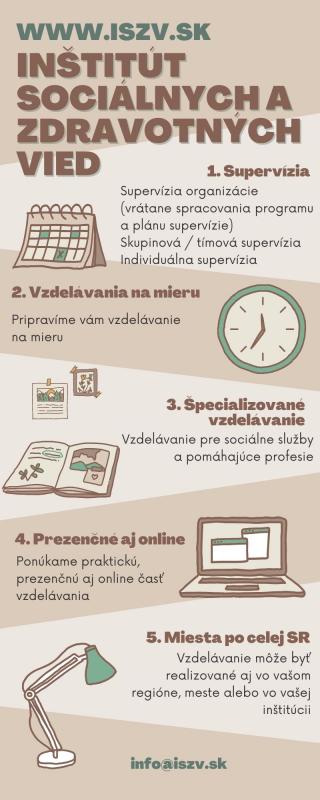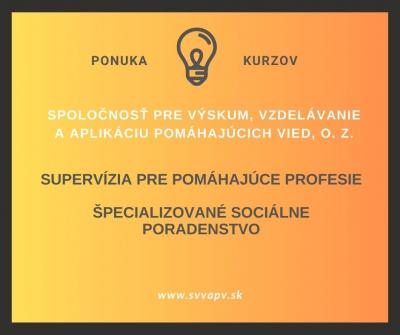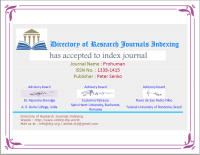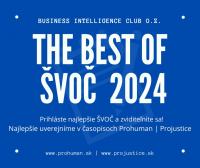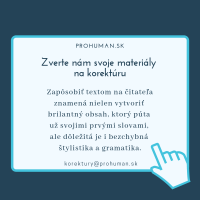Abstract: Artephyletics combines art and education and with its focus supports the development of students' strengths and at the same time acts preventively against emotional and psychosocial problems. Slavík (2001) defines artephyletics as reflective, creative, and experiential education and therefore appears to be a suitable support method for students in inclusive education. It uses drawing, painting, and modelling techniques, with which students can learn to solve their own emotional problems, improve social skills, control behaviour, deal with stress and increase self-awareness. Creative artistic activity also creates a relaxation response and improves mood. The presented article explains the concept of artephyletics and offers the descriptions of possibilities of using this approach in inclusive education - especially in the education of pupils with special educational needs.
Keywords: artephyletics, inclusion, inclusive education, students at risk, students with special educational needs, support
Introduction
The main goal of education in the Slovak Republic is an inclusive system that provides support to all pupils and students with respect for their individual characteristics and diverse educational needs and enables them to fulfil their potential to the highest possible extent. At the same time, the inclusive approach aims at the support and development of every person participating in the development of a pupil or student. The long-term intention is to create an environment that will motivate schools to become inclusive and at the same time motivate parents to perceive schools on the path to inclusive education. A key moment in the development of inclusive education was the adoption of the UN Convention on the Rights of People with Disabilities (2006), which establishes the right of people with disabilities to study in the inclusive education system, obliges states to transform education and promotes the support of inclusive education. In this document, the contracting parties recognize the right of persons with disabilities to education. To enforcement this right without discrimination and based on equal opportunities, the contracting parties shall ensure an inclusive system of education at all levels. In our country, inclusion in education is officially regulated by several legal regulations, specifically in the Constitution of the Slovak Republic (Articles 38, 42), in the Act of the Slovak Republic No. 245/2008 Coll. on Education and Training (School Act). From 2020, the inclusive approach in Slovakia is supported by the Ministry of Education, Science, Research and Sport of the Slovak Republic. For the first time in history, in the mentioned year, a separate department of inclusive education was established at the Ministry of Education. The department declares that the state educational program must be pro-inclusive, built in such a way that it accepts the educational requirements of all children, pupils, and students without exception, that is, pupils and students with diverse needs, with a health disadvantage, from a socially disadvantaged environment, foreigners, pupils and students of different nationalities, migrants or pupils and students with talent. Given that the provision of inclusive education is very regionally specific, it will require the cooperation of all stakeholders at different levels. The current amendment to the Education Act of 2023 entitles all pupils and students to receive support in education and training. The system of support measures is a means of implementing inclusive education. The aim of the amendment is to expand the concept of special educational needs by other groups of difficulties and specifics, for example in language and cognitive abilities, motivation and emotionality or skills. The new system tries to consider other problems of pupils and at the same time better respond to the needs of talented pupils in the development of their personal potential by specially developing their creativity or other skills. Support measures are designed based on different types of diagnostics. In the set model, the provision of support measures is directly linked to the five levels of support of the counselling and prevention system. The amendment to the Education Act is followed by a catalogue of support measures. Accompanying material and methodological instructions were created for each measure, which describe who, to whom, when and under what conditions provides the said support measures.
Artephyletics as a support tool in education
Artephyletics as a concept was developed from the late 1880s to the early 1920s in the Czech Republic. It is an educational method that is originally based on art education. A reflective, creative, and experiential aspect is important in artephyletics. It is based on cultural manifestations, namely visual, dramatic, musical or dance. It consists of two basic parts. The first part originates from the Latin word ars, artis - art, leading to art therapy. The second part "phyletic" is an approach to education in which a person's social and emotional feelings are developed. Artephyletic offers personal development, a source of self-knowledge or the development of creative thinking through personal experience. Creative activities provide an opportunity to express their experiences and knowledge, feelings and wishes (Sender, 2022a). Methodologically, artephyletics is based on two interrelated principles - expression and reflection (Slavík, 2001). Artephyletics was created for the purpose of bringing education with personal experience closer to the individual's own experience. This experience is intended to deepen cultural sensitivity, cultural knowledge, and self-knowledge. It draws from modern visual arts, especially action creation (Slavík, 2001). Within artephyletics, art is understood broadly, especially as all ordinary creative activities and everyday phenomena. Slavík (2004) used Broudy's (1976, In Slavík, 2004) topic for a phyletic understanding of education (phyletic approach) to create an arte-phyletic structure of a specific form of encounter (encountering), in which art and dialogue are connected. Závora (2009) describes artephyletics as a salutogenetically oriented approach, which focuses on the knowledge of risk factors and the support of protective factors and individual potentials. Action creation is closely related to creativity education or communication skills training. In action creation, the border of art disciplines is deliberately crossed, and various expressive tools are also used. It is a creation where the intention is not to produce, but to create. The intention is the process itself, not the artistic creation (artifact). So, the goal is not painting a picture or modeling a sculpture, but creativity during the process itself. A video recording or a photograph can serve as a reminder of an artephyletic meeting (Zhoř, 1991). Artephyletics is based on two sources - art therapy and the modern concept of art education. However, it is important not to confuse artephyletics with art therapy. Although artephyletics uses similar methods as art therapy, it does not have the main goal of treating psychological problems. It is used in the field of education or as a prevention of socially pathological phenomena (Potměšilová & Sobková, 2012). These two disciplines have many in common, apart from the already mentioned art techniques and subsequent reflection, especially goals. In artephyletics, it is self-knowledge, the development of the social side using artistic methods. In both cases, the activities can be carried out in a smaller group in a circle (Géringová, 2011). However, both disciplines can also have common goals, such as resocialization, re-education, integration or inclusion. An effective approach in education and in a therapeutic environment is the transfer of experience, but not knowledge in the form of memorization. Artistic activities are also effective in the education process. The same goal in both cases is a positive impact on pupils and students with special educational needs (SEN) within the framework of inclusion (Sender, 2021a). Through properly targeted methods, a healthy person will be brought closer to an individual with special educational needs. The common features of both approaches can also be seen in the emphasis on respect for individuality, uniqueness, identity, and otherness (Šicková, 2016).
Artephyletics in inclusive education
The use of artephyletics in teaching is extremely important when working in an inclusive classroom. Pupils and students at risk or with SEN tend to be demotivated, tired and have low self-esteem at school. These students need to be shown that although they have difficulties in some area, there are areas in which they can excel. This increases their self-awareness, self-acceptance and, in the long term, their self-confidence. It is therefore necessary to include emotions in learning and teach students to receive and create feedback. Thus, the role of teachers is gradually changing from simply conveying information and knowledge to accompanying students in learning about the world and developing their abilities and positive qualities. Artephyletic approach respects the individual pace of students, increases imagination, creative and critical thinking. It supports student creativity through activities and home projects and at the same time introduces new opportunities for learning in a safe and supportive environment (Sender, 2021b). Education is aimed at all-round development, and therefore it is desirable to include activities and games in the teaching, with the help of which it is possible to fulfil intellectual, physical, and emotional elements. Encouraging positive emotions makes it easier for students to master even more demanding tasks that require overcoming obstacles. The use of artephyletics in teaching helps students not to succumb to stress and resist even adverse circumstances. These are factors that help them overcome difficult life situations. If the individual copes with his problems, artephyletic activities can offer him guidance on how to respond the next time he encounters difficulties. The school should strengthen competences, which are an inherent basis for coping with life (Líšková, 2014). For all pupils and students, creative activity is a suitable means for training will, patience, concentration, and at the same time supports imagination and creativity. A significant advantage is also the fact that students are led to a deeper interest, forced to suppress their destructive tendencies, learn to value their work as well as the works of others. At the same time, in a natural and non-violent way, they contribute to increasing creativity and imagination. Creativity is one of the most important factors contributing to the feeling of happiness, fulfilment, and self-realization (self-worth), but despite this, it is not sufficiently supported in the today's school. Creativity is involved in school success, healthy psychological functioning, and maintaining healthy peer relationships (Csikszentmihalyi, 1990). Artephyletic activity offers great potential for relaxation and strengthening of self-evaluation and inner experience. For this reason, we believe that these procedures can be used by all educators when working with children and adolescents. The pedagogical process implemented in our schools has two basic components: education and training. It is a process in which a person's personality is formed. Thus, the field of education and phyletic overlap in many areas. A competent educator can use various phyletic elements during the pedagogical process and thus contribute to the improvement of the school and classroom climate, classroom relationships, learning results and student performance, their joy in creating, and thus also to the increase of creativity and creative thinking (Sender, 2022b). Ford and Harris (1992) propose to understand creativity as a modifiable thinking process, the result of which is the creation of a unique and useful product. Creativity is subject to environmental influences, especially purposeful educational influences, it can be trained and developed. When developing students' creativity in teaching, it is necessary to respect the fact that the development of their psychological processes and properties, intellectual and creative abilities does not take place in the same way and at the same pace. Therefore, each student needs specific stimuli for his creative performance, which can mobilize his creative activity and abilities (Lokšová, 2002). Unfortunately, for many teachers, developing students' creativity in school represents extra work (Beghetto & Plucker, 2006) and an extracurricular activity. In worse cases, teachers evaluate student creativity and original ideas as disruptive (Beghetto, 2007) and assume that their support will lead to indiscipline and disruption in classes. At the same time, creativity is associated with economic and financial prosperity (Florida, 2002), physical health, social harmony, and mental well-being.
Artephyletic techniques and materials
The method of free associations is most often used in practice, which consists in the fact that students produce associations to some object or to a set of elements that appear in art artifacts. These are especially expressive elements that attract attention with their proportions, colours, bizarreness, etc. Lhotová and Perout (2018) claim that these free associations can stimulate the "aha-effect" and address students in relation to their problems, thereby contributing to the creation of insight. Schools are an important place for cultivating and developing creativity. It is appropriate to use various non-traditional methods and approaches in education and to give students tasks in which they can use their creativity and originality. As we already mentioned, increasing creativity has many benefits for students. School classes represent opportunities, especially for pupils with SEN, to be able to appreciate human creativity and develop their own gifts and talents. Various methods are applied in the investigation of creation and in the assessment of processes in artephyletics regarding their usefulness within individual conditions and a specific focus. It is a set of procedures or steps that lead to a given goal through artistic creation. It is important to be aware of the methods within the temporal succession of two stages, i.e., the phase leading from the targeted entry of art themes, through the monitoring of the creation processes and the phase of subsequent work with art artifacts in individual and group form after its completion. The specific level includes techniques, that is, specific procedures chosen with the intention of using a certain method effectively. Sometimes the terms method and technique are confused. Artephyletic techniques used in various art forms represent specific means of expressing a relationship and enable students to create surface and spatial forms. These techniques are directly related to artistic and aesthetic means of expression, from which the artistic form is created. A means of expression can be e.g., a line that is applied in a flat or three-dimensional drawing (Sender, 2023). Through the material (e.g., paints, clay, pencils), the techniques provide the conditions for the creation of a perceptible form and its content. Artephyletic techniques are similarly divided according to various criteria. Traditionally, this division was based on the division of art. Accordingly, the techniques were divided into drawing, painting, graphic and modelling techniques. However, the current practice has brought expansion in the form of newer, so-called non-traditional techniques. We offer a breakdown of the most common artephyletic techniques in an overview table (table. 1).
Table.1: Overview of Artephyletic Techniques
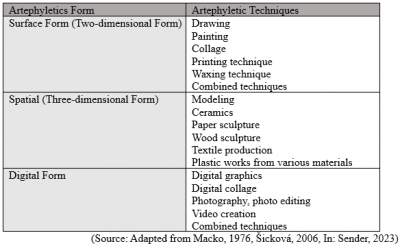
Metaphors, symbols, and the expressive use of artistic materials combine to create a rich language for self-expression and the possibilities of transforming strong emotions into a visual expression that can be visceral in its intensity. Differences in scale or perspective, tone, and colour together with the use of metaphors allow for potentially sophisticated articulation of students' thoughts and feelings. Symbolism is multifaceted and can contain multiple and conflicting meanings. The use of symbols allows the expression of moods and intangible thoughts or qualities that would otherwise be difficult to express. Silent embodied feelings can be sensed and explored through manipulation and different types of materials. The process of creating artwork is potentially revelatory, it can trigger strong feelings and reveal previously unexpressed issues. The materials used in artephyletics, their very essence, can be suggestive. It is a sensory process in which the movements of the body and the tactile perception of materials are interconnected.
Conclusion
The effort of inclusive education is to solve the possibilities of supporting individuals with SEN (but not only them) with the aim of the best possible social adaptation. During their professional training, teachers acquire knowledge and competences to intervene in various ways. These intervention methods include diagnosing problem areas, leading and facilitating the educational process, implementing re-education, compensating for deficiencies, etc. However, Müller (2014) declares that this list is far from exhausting all possibilities. In inclusive pedagogy, there is a blurring of boundaries and thus also an expansion of the potential competences of all actors. These competences relate mainly to the possibility of using specific approaches that have a phyletic focus and therefore enrich the spectrum of methods, techniques, and ways of support. However, this penetration does not take place one-sidedly, and as a result, there are gradual changes in theory and practice. Thus, there is a noticeable trend of using educational approaches with phyletic potential. Pedagogical and professional staff can use artephyletics individually or in groups. The individual form is chosen in the case when it is necessary to focus on only one student and in the case when his problems are more internal in nature. It is also advisable to choose it at the beginning of cooperation, where inclusion in the group could have a negative effect (Šicková, 2008). It is a form that creates a more personal relationship between teacher and student. Therefore, it is necessary to observe the exact rules that will be fulfilled within this relationship. This is mainly about respecting the student in his choice of depth of penetration into the given assignments and topics (Müller, 2014). Group artephyletics can be used if the individual form is too intense for the individual. Working with a group brings many advantages. Group members mutually provide feedback, within which the desired role can be consolidated and strengthened (Liebmann, 2006). Most experts agree that artephyletics helps students deal with their emotional and behavioural problems by allowing them to express their anger and frustration through art (Gliga, 2011). With artephyletics, there is a certain level of comfort and a sense of security that you will not find to the same degree in common forms of intervention or re-education. Pupils' feelings and experiences are transformed into concrete and tangible images, making it possible to gain a new perspective on problems and conflicts. With increasing pressure to complete re-education in the shortest possible time and with a limited number of sessions, school support team members are discovering the potential of artistic expression to help students quickly communicate relevant issues. For this reason alone, experts in the helping professions increasingly use drawings and other expressive art tasks during intervention.
Author: PhDr. Andrea Franta
Constantine the Philosopher University in Nitra, Faculty of Education, Department of Pedagogy
Project: KEGA 011UKF-4/2023 - Artefiletic Support Program For High School Students With Learning Disabilities
References
BEGHETTO, R. A., & PLUCKER, J. A. (2006). The Relationship Among Schooling, Learning, and Creativity: "All Roads Lead to Creativity" or "You Can't Get There from Here"? In J. C. Kaufman & J. Baer (Eds.), Creativity and reason in cognitive development (pp. 316–332). Cambridge University Press. https://doi.org/10.1017/CBO9780511606915.019
BEGHETTO, R. (2007). Does creativity have a place in classroom discussions? Prospective teachers’ response preferences. Thinking Skills and Creativity, 2,19.http://dx.doi.org/10.1016/j.tsc.2006.09.002
CSIKSZENTMIHALYI, M. (1990). Flow: The psychology of optimal experience. New York: Harper Collins Publishers. ISBN 978-00-613-3920-2.
FLORIDA, R. (2002). The Rise of the Creative Class and How It’s Transforming Work, Leisure, Community and Everyday Life. New York: Basic Books.
FORD, D. Y. a J. J. HARRIS, (1992). The elusive definition of creativity. In: The Journal of Creative Behavior. Vol. 26, No. 3, pp. 186-198.
GÉRINGOVÁ, J. (2011). Pomáhající profese: Tvořivé zacházení s odvrácenou stranou. Praha: Triton. ISBN 978-80-738-739-43.
GLIGA, F. (2011). Teaching By Art Therapy. December 2011. Procedia - Social and Behavioral Sciences 15(2):3042-3045. DOI: 10.1016/j.sbspro.2011.04.241.
LHOTOVÁ, M., PEROUT, E. (2018). Arteterapie v souvislostech. Praha: Portál. ISBN 978-80-2621-272-0.
LIEBMANN, M. (2010). Skupinová arteterapie. Praha: Portál, ISBN80-7178-864-3.
LÍŠKOVÁ, B. (2014). Citová a emocionální výchova v rodině a ve škole. Hradec Králové : Gaudeamus. ISBN 978-80-7435-398-7.
LOKŠOVÁ, I. (2002). Koncepcia tvorivého vyučovania. Pedagogická orientace, 2002, č. 3, s. 55-70. ISSN 1211-4669.
MÜLLER, O. (2014). Terapie ve speciální pedagogice. Praha: Grada. ISBN 978-80-247-4172-7.
POTMĚŠILOVÁ, P., SOBKOVÁ, P. (2012). Arteterapie a artefiletika nejen pro sociální pedagogy. Olomouc: UP, ISBN 978-80-2443-120-8.
SENDER, B. (2021a). Využívanie prvkov arteterapie pri vytváraní pozitívnej klímy v inkluzívnej triede. In: QUAERE 2021 : recenzovaný sborník příspěvků interdisciplinární mezinárodní vědecké konference doktorandů a odborných asistentů. Hradec Králové: Magnanimitas. ISBN 978-80-87952-34-4.
SENDER, B. (2021b). Jogový program s prvkami arteterapie pre deti a možnosti jeho využitia vo výchovno-vzdelávacom procese. In: MERICA, M., BELEŠOVÁ, M. Žiak, pohyb, edukácia 2021. Bratislava : UK, 2021. ISBN 978-80-223-5248-2.
SENDER, B. (2022a). Využitie prvkov tanečno-pohybovej terapie v inkluzívnej triede bežnej základnej školy. In: MERICA, M., BELEŠOVÁ, M. Vedecký zborník 2022 – Žiak, pohyb, edukácia. UK. ISBN 978-80-223-5471-4.
SENDER, B. (2022b). Artefiletika ako forma podpory žiakov s poruchami správania. In: ŠILONOVÁ, V., KOŽÁROVÁ, J. Podpora inkluzívneho vzdelávania na Slovensku a v zahraničí . Prešov : PU, 2022. ISBN 978-80-555-2995-0.
SENDER, B. (2023). Arteterapeutické šablóny pre deti. Trenčín: Susan Slovakia. ISBN 978-80-974490-0-1.
SLAVÍK, J., (2001). Umění zážitku, zážitek umění (teorie a praxe artefiletiky). I. diel. Praha: Univerzita Karlova – Pedagogická fakulta. ISBN 80-7290-066-8.
ŠICKOVÁ – FABRICI, J. (2008). Základy arteterapie. Praha : Portál, ISBN 80-7178-616-0.
ŠICKOVÁ – FABRICI, J. (2016). Arteterapia – užitkové umenie? Martin : Petrus, ISBN 80-8923-310-4.
ZHOŘ, I., HORÁČEK, R., HAVLÍK, I. (1991). Akční tvorba. Olomouc: Rektorát Univerzity Palackého v Olomouci. ISBN 80-7067-074-6.
Constitution Of The Slovak Republic (Articles 38, 42)
Act Of The National Council Of The Slovak Republic No. 245/2008 Coll. On Upbringing And Education (School Act)
